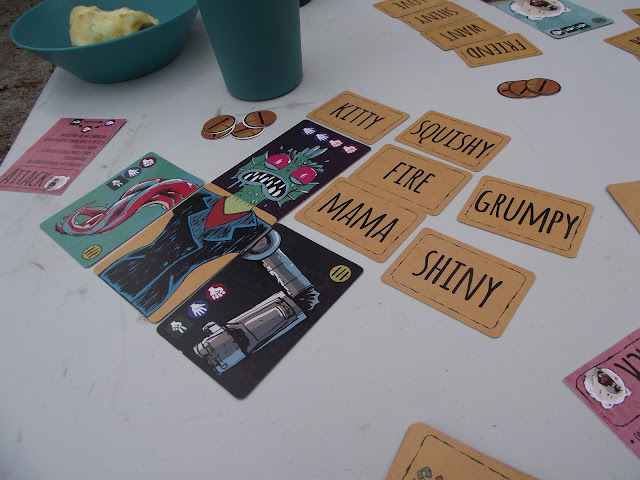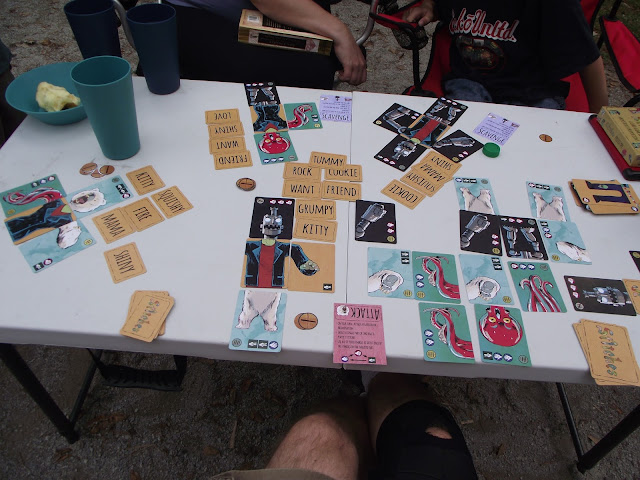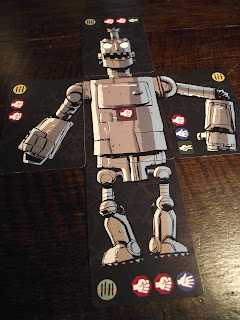 |
| Stitches Designers: Jason Rankin & Doug Brinbury Publisher: Norwester Games, LLC |
Disclaimer
Franken State University is known for its thesis projects that get abandoned in the forest at the end of each semester. Monsters roam the woods searching for body parts that are better than what they have, either by scavenging whatever they can find, or by attacking other wandering monsters. As the monsters interact they can start to learn a rudimentary language, which may come in handy to defeat the Abomination, a creature that has been in the woods for so long that no one has any idea what it was originally intended to be.
In Stitches each player takes on the role of one of these abandoned thesis projects. Through an easy to learn rock-paper-scissors combat mechanic players will work together, somewhat, to upgrade their monsters and then cooperatively try to defeat the Abomination. The catch is, players can only communicate through grunts, growls, groans (and other sounds that start with 'G'), and the few words they have managed to learn.
If you think this sounds like a ton of hysterical fun, you're not alone. When I was contacted about reviewing Stitches I read the description and couldn't wait to get my hands on it. It sounded like a total blast to play.
You can find Stitches on Kickstarter right now. It's only $20 (plus shipping) and will be available through November 16.
Overview:
In Stitches, 3-7 players each take on the role of a monster. Each player will have a body as well as four limbs (head, left arm, right arm, and legs). Each limb will have a number of symbols on it, corresponding to the traditional rock, paper, or scissors. Players will also have stitches tokens, which are the currency in the game, and words that they have learned over the course of the game. Words allow players to cooperate with other players that know the same words. To set up the game each player starts as a monster with basic parts, two Stitches, and one word. Then the Abomination is created with one Abomination torso and one Abomination head as well as one random body part from the main deck. There are multiple Abomination heads and torsos, so there are plenty of different setups. The first player is the one who woke up feeling most like a monster that morning.
 |
| Set up and ready to go. |
 |
| Yes, he's eating an apple and pickles from the jar while we play in a campground. (OK, I confess, I had some pickles, too.) |
Then, proceeding in turn order, each player takes their chosen action. If a player chose Scavenge a new body part is drawn and added to the Market. Then the player can spend Stitches to purchase as many body parts from the market as they want and can afford. If a player chose Attack they have three choices: Steal another player's Stitches, Attack another player's body part, or Attack the Abomination. If you choose to steal someone else's Stitches you can steal half (rounded up) of their Stitches tokens. If you choose to Attack another player you can choose one of their limbs to attack. If you are successful you steal that body part (more about how combat works in a bit). For either of these options both players get to draw a new Word card and add it to the words they know. If you decide to Attack the Abomination then every other player that has at least one word in common with you must also fight the Abomination. Generally the Abomination is going to be too strong for one player to attack, but it's possible for several players to team up in this way to defeat the Abomination. More about how fights with the Abomination work in a bit.
 |
| Scavenging will get you more parts, but Attacking will get you someone else's parts, plus you'll learn a word! |
Attacking the Abomination works pretty much the same way, except each player on the team attacks in turn. When a limb on the Abomination is defeated the player doesn't get to add it to their monster right away though. Instead the Abomination will target the player's body part that has the highest Stitches value and will counter attack that body part. If the Abomination is successful the player loses that part. Then the attack moves on to the next monster on the team. That player will have the chance to press the attack on the Abomination, attempting to defeat another body part (and then being subject to a counterattack by the Abomination). If that player doesn't want to attack they can retreat instead. But the first player to retreat will lose one of their words. Attacks of the Abomination continue until everyone on the team has retreated. This means some players may have to attack the Abomination more than once, potentially losing another body part each time they do. So even though the Abomination will be getting weaker the longer an attack goes on, so will the monsters attacking it. It's generally a good idea to wait until late in the game to attack the Abomination, when there are a number of players that share words and have a few fairly strong body parts.
 |
| That swamp monster head came from a failed attack on the Abomination, but at least someone came out ahead (ba dum bum). |
Final Thoughts:
Unfortunately my gaming groups found Stitches more fun in concept than in reality. The mechanics throughout the game felt awkward, the restriction to grunting and using only words that your monster has learned felt gimmicky, and the cooperative aspect of the game felt very dull. The first group I played with had mixed reactions, ranging from unimpressed but willing to give it another shot to never wanting to see the game again. I played later with my family and none of them have any interest in playing again. I was disappointed because I thought the concept sounded lighthearted and fun, but I, too, wasn't impressed with the game at all. I still think with the right group, and with players who already are familiar with Stitches it could still be fun, but it's too much effort to get to that point when there are plenty of other games that can be played instead.
I'll go ahead and get a bit more specific about a few of the issues we had with the game. Right away there were problems with the rulebook. There are a lot of ambiguous areas in the rules that don't really become apparent until you actually start playing (e.g. the rules don't specifically say that the Abomination has to be able to defeat a body part in its counterattack). So even though I read through the rules several times before playing for the first time when we started playing with seven players there were a number of areas that left us scratching our heads. So, hopefully that will all get cleared up in the final version of the rulebook (I had received an email with several updates to the rules, so things were still being tweaked after I was sent my copy).
No one I played with enjoyed the communication restrictions, maybe because the game was new for everyone. The communication restrictions are especially ineffective when playing with new players since there are so many fiddly rules that really need to be discussed during the first game play. I can see where the communication limitations could be fun with experienced players, but it's a rule that will most likely be ignored during teaching games. Even with experienced gamers, the only time communication becomes important is when trying to make a plan to take out the Abomination. Until that point the game is mostly about individual decisions.
 |
| Stitches wasn't a winner and they quickly asked to move on to something else. |
 |
| You do get to piece together pretty weird and fun monsters though. |
Scavenging is similarly dull, with players either gaining a windfall of stitches tokens and buying a few upgraded parts only to have them stolen by later attackers, or so many players scavenging that you end up with too few tokens and too few market options to make a meaningful purchase. There also didn't seem to be a whole lot of difference between a 4-stitch and 3-stitch limb, or a 5-stitch and 4-stitch limb. There was a tiny difference in the allocations of symbols, but not enough to make me care.
I'd love to see a much wider range of numbers and combinations of symbols on the cards. As it is, once a monster gets three or four upgraded parts almost any individual part can easily be defeated. A wider range of symbol counts might make this a bit more challenging and strategic. I don't know if that will throw off any balance, but the current distribution of parts doesn't feel like there is enough variety. I'd also like to see the cooperative nature of the game pushed even more, or less. Make it so that there's an ultimate winner. The semi-cooperative nature of the game made the PvP combat seem out of place and at odds with the attempt to defeat the Abomination as a team.
The one area where Stitches shines is in the artwork. The creature artwork matches the humor of the theme wonderfully. The art is done by Kyle Ferrin, the artist behind Vast: The Crystal Caverns. It doesn't have quite the same overall atmosphere as Vast, but for the game's mechanics the artwork works perfectly. I love creating different combinations of body parts to create different monsters. The cards alone can provide quite a bit of entertainment, especially for younger gamers.
There is something here though. With the right group of people that are already familiar with the game and willing to strictly follow the communication restrictions Stitches can be a silly fun time. There actually can be quite a bit of cooperative strategy in the game if players try to communicate so one player scavenges, gaining all the stitches so they can buy some good parts from the market and then get them distributed to other players through coordinated attacks. This is easy to coordinate when you can speak freely, but it is much more difficult when you can only grunt. The problem is that this type of cooperation requires a lot more work than the casual and silly theme and focus on PvP attacks implies. I feel that type of strategic thinking will be beyond most of the target audience for this game.
So, while I really like the theme and humor behind Stitches, the game felt too discombobulated and rough around the edges for me to recommend at this time. It felt like something that was fun for the creators and rushed to production instead of being given the time and effort needed to turn a fun, silly idea into an elegant, smoothly flowing game. If you are willing to put in the time to really learn Stitches and you have players that are ready to be silly, you might want to check out Stitches, but it's just a little too fiddly and complex to really work with the casual and noob gamers that seem to be the target audience.
You can find Stitches on Kickstarter right now. Through November 16, Stitches will be available for $20, plus shipping ($7 in the US).
Preliminary Rating: 5/10
This review is of a prototype game. Components and rules are not final and are subject to change.

Did you like this review? Show your support by clicking the heart at Board Game Links , liking GJJ Games on Facebook
, liking GJJ Games on Facebook  , or following on Twitter
, or following on Twitter  . And be sure to check out my games on Tabletop Generation.
. And be sure to check out my games on Tabletop Generation.
GJJG Game Reviews are independent, unpaid reviews of games I, George Jaros, have played with my family and friends. Some of these games I own, some are owned by friends, some are borrowed, and some are print and play versions of games. Where applicable I will indicate if games have been played with kids or adults or a mix (Family Play). I won't go into extensive detail about how to play the game (there are plenty of other sources for that information and I'll occasionally link to those other sources), but I will give my impressions of the game and how my friends and family reacted to the game. Quick Reviews will only get a single rating of 1-10 (low-high) based on my first impressions of the game during my first few times playing. Hopefully I'll get more chances to play the game and will be able to give it a full review soon.
Preliminary Rating: 5/10
This review is of a prototype game. Components and rules are not final and are subject to change.

Did you like this review? Show your support by clicking the heart at Board Game Links
 , liking GJJ Games on Facebook
, liking GJJ Games on Facebook  , or following on Twitter
, or following on Twitter  . And be sure to check out my games on Tabletop Generation.
. And be sure to check out my games on Tabletop Generation.GJJG Game Reviews are independent, unpaid reviews of games I, George Jaros, have played with my family and friends. Some of these games I own, some are owned by friends, some are borrowed, and some are print and play versions of games. Where applicable I will indicate if games have been played with kids or adults or a mix (Family Play). I won't go into extensive detail about how to play the game (there are plenty of other sources for that information and I'll occasionally link to those other sources), but I will give my impressions of the game and how my friends and family reacted to the game. Quick Reviews will only get a single rating of 1-10 (low-high) based on my first impressions of the game during my first few times playing. Hopefully I'll get more chances to play the game and will be able to give it a full review soon.























No comments:
Post a Comment